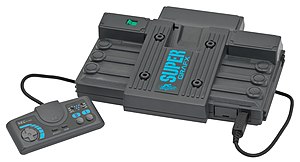SuperGrafx

PC Engine SuperGrafx system
|
|
| Manufacturer | NEC Home Electronics |
|---|---|
| Type | Video game console |
| Generation | Fourth generation |
| Release date |
|
| Media | HuCard, CD-ROM |
| CPU | Hudson Soft HuC6280 |
| Best-selling game | Daimakaimura |
| Predecessor | PC Engine (main system) |
| Successor | PC Engine Duo (updated system) |
The PC Engine SuperGrafx (PCエンジンスーパーグラフィックス Pī Shī Enjin SūpāGurafikkusu?), also shortened as the SuperGrafx or PC Engine SG, is a video game console by NEC Home Electronics, released exclusively in Japan. It is an upgraded version of the PC Engine.
Originally announced as the PC Engine 2 (PCエンジン2 Pī Shī Enjin Tsū?), the machine was purported to be a true 16-bit system with improved graphics and audio capabilities over the original PC Engine. Expected to be released in 1990, the SuperGrafx was rushed to market, debuting several months earlier in late 1989 with only modest improvements over the original PC Engine.
Only seven games were produced which took advantage of the improved SuperGrafx hardware, and two of those could be played on a regular PC Engine. However, the SuperGrafx is backwards compatible with all PC Engine software in both, HuCard and CD-ROM² format, bringing the compatible software total up to nearly 700. The system was not widely adopted and is largely seen as a commercial failure.
Compared to the PC Engine, the SuperGrafx has four times the amount of working RAM for the main CPU and a second video chip with its own video RAM. Also included is a priority controller chip, which allows the output of both video chips to be combined in various ways. The SuperGrafx has support for two independently scrolling background layers, like the Mega Drive, as opposed to the PC Engine's single layer.
It is a very common misconception that the extra video hardware capabilities were taxing on the system's CPU, and is often cited as the main reason few games were developed for the system. In reality, despite having the same CPU as the PC Engine, the SuperGrafx is more than capable of keeping up with the new graphics enhancements, as the majority of the workload is handled by the VDPs.
...
Wikipedia
